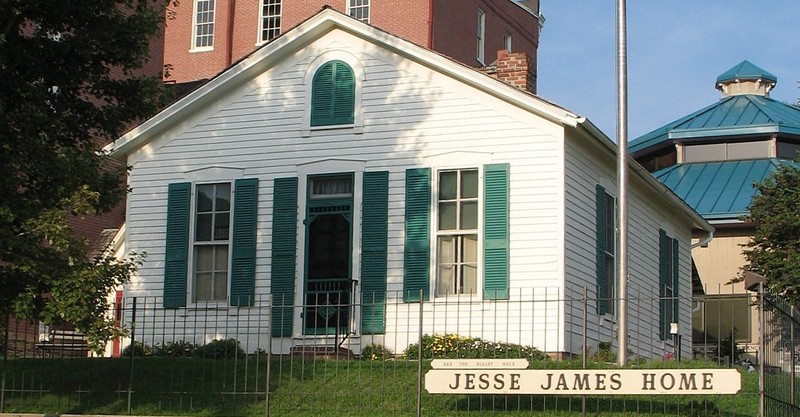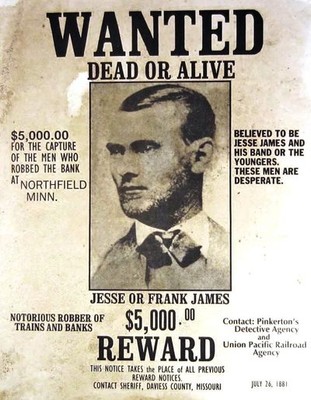Jesse James Home Museum
Introduction
Text-to-speech Audio
The museum, adjacent to the historic Patee House Museum, was once home to the outlaw Jesse James, and it was here where he was shot and killed at 34 years old in 1882. James lived here with his wife and children under the fictitious name of Tom Howard. As he stood on a chair to straighten a picture hanging on the wall, a member of his gang, Bob Ford, shot and killed James to collect the $10,000 reward offered by Missouri Governor Tom Crittenden. Today, the home is a museum with numerous artifacts and memorabilia associated with Jesse James, a man who justified his many murders and robberies as a means of supporting the Confederacy while also refusing to accept the results of Reconstruction.
Images
Jesse James Home Museum

1881 Wanted Poster for Jesse James

Backstory and Context
Text-to-speech Audio
The son of a planter and preacher, Jesse James, grew up on a 100-acre plantatoin tended at ties by free workers and seven people who were enslaved by his father. An outwardly religious child and young man, many believed he might become a minister like his father. Instead, James lived a life of thievery and violence against Unionists, enslaved people, and free Black Americans.
Although Missouri remained part of the Union as a border state during the war, James and his family passionately supported the South. Frank James, Jesse's brother, fought as a Confederate soldier at the Battle of Wilson's Creek before joining Confederate guerrillas and raiders; Missouri and eastern Kansas endured numerous brutal guerrilla battles that included harming civilians and destroying towns. Union soldiers visited the James homestead in 1863, seeking information on Confederate guerrillas. The soldiers allegedly hurt some of the James family and threatened them. As a result, an angry Jesse James joined his brother in guerrilla raids,
James survived a bullet to the chest during an attack in the summer of 1864, which allowed him to join a September raid in Missouri referred to as the Centralia Massacre. James joined eighty men in killing and mutilating more than 100 Union soldiers. James took credit for killing Union commander Major Andrew "Ave" Johnston. He learned as a guerrilla soldier how to plan an attack, act swiftly, flee, and then hide, all skills he used as a criminal after the war. Historian James McPherson's recent book This Mighty Scourge includes an essay with Jesse James' biographer T. J. Stiles. Together, the two historians take on the myth of Jesse James as a hardscrabble outlaw.
Jesse James refused to take the Confederate defeat lightly. He again healed from a gunshot wound at war's end. His cousin and future wife, Zerelda Mimms, nursed him to health while his former guerrilla mates robbed banks and stagecoaches; James later joined them and began his life of crime. His resentment for the Union Army materialized during an 1869 bank robbery where he shot the cashier because James believed him to be the man who killed James' former commander a month after the Centralia Massacre. After three years of robbing banks, James' choice to shoot the cashier in 1869 as an act of Civil War revenge put Jesse James' name in the papers for the first time. James also wrote letters to Kansas City Times editor and Confederate sympathizer John Edwards in which he explained his innocence and rationale for his actions. Edwards happily published the letters and added his own editorials that praised Jesse James as a Robin Hood figure and hero of the resistance against the Union during Reconstruction when the federal government took control of the Missouri government.
All told, Jesse lived a life of crime for sixteen years. He maintained his innocence, comparing himself to such historical military commanders as Napoleon, Julius Caesar, and Alexander the Great. The "James Gang" robbed banks, stagecoaches, trains, and even a county fair in Kansas City. Although the famed Pinkerton Detective Agency began their pursuit of the James brothers and the gang in 1871, the outlaws never feared any repercussions, and James appeared to feed off the attention he received. Confederate sympathizers sheltered the gang, allowing them to elude authorities.
However, Jesse and Frank James appeared to let their egos get the best of them in 1876 when the gang traveled nearly 500 miles from their safe haven to rob a bank in Northfield, Minnesota. Although Frank and Jesse escaped, the town and law enforcement responded to the robbery by killing two of the gang and hunting down the rest. Thus, Jesse and Frank had to escape to Tennessee and live under assumed names; Jesse took the name "Thomas Howard," and Frank became "B. J. Woodson."
The Northfield bank robbery debacle served as the first step towards Jesse James' downfall, ending with his death at his home in St. Joseph. Though his gang began as a southern-sympathizing movement, the death and arrests of his partners in Minnesota forced Jesse to recruit new men into the gang. Thus, instead of planning crimes with former war comrades, he associated with simple criminals who had no fondness for the former Confederacy (the war had been over for a decade by that time). Jesse James never fully trusted his new "friends," and his instincts eventually proved correct. In 1882, James, living under his alias, moved his family back to St. Joesph. Unbeknownst to him, one of his two new men, Robert Ford, had already talked with Missouri Governor Thomas Crittenden and arranged to collect $10,000 for killing Jesse James.
On April 3, 1882, Robert Ford shot and killed Jesse James in the home that now serves as a museum. Although Ford and his brother were found guilty of murder, Crittenden pardoned them. Still, they never received the reward money. Meanwhile, Frank eventually turned himself into authorities but, was aquitted in several trials in various states. He went on to live a quiet life, dying naturally.
More than a century after Ford shot Jesse James, in 1995, forensic scientist James Starrs exhumed the outlaw's body at Kearney, Missouri, for DNA tests, which confirmed it was James' body. Visitors can now see artifacts from the grave at the museum, which include coffin handles, a small tie pin Jesse James was wearing the day Ford shot him, and a bullet that entered one of James' lungs.
The Pony Express Historical Association manages the Jesse James Museum. Admission fees directly support the maintenance of the James home and the adjacent Patee House Museum.
Sources
"Biography: Jesse James." Public Broadcasting Service (PBS). American Experience. Accessed July 16, 2024. https://www.pbs.org/wgbh/americanexperience/features/james-jesse/.
"Jesse James Home." St. Joseph, Missouri. stjosephmo.gov. Accessed July 16, 2024. https://www.stjosephmo.gov/362/Jesse-James-Home
Patee House Museum & the Jesse James Home. Accessed July 16, 2024. http://www.ponyexpressjessejames.com/.
Trout, Carlynn. "Jesse James." Historical Missourians. State Historical Society of Missouri. Accessed July 16, 2024. https://historicmissourians.shsmo.org/jesse-james/.
CC BY-SA 2.5, https://commons.wikimedia.org/w/index.php?curid=1118571
https://www.carleton.edu/admissions/blog/all-about-jessie-james/
